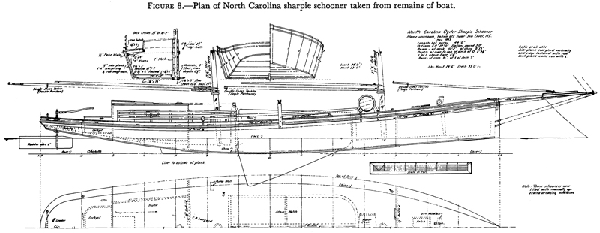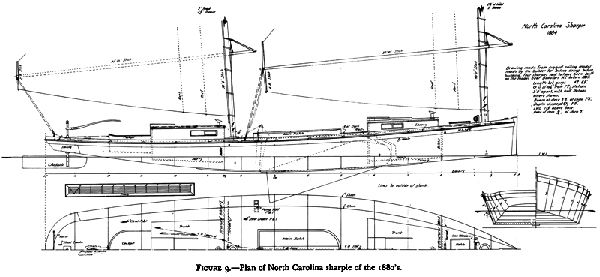The North Carolina Sharpie [p 149]
Because the oyster grounds in the Carolina Sounds were some distance from the market ports, boats larger than the standard 34- to 36-foot New Haven sharpie were desirable; and by 1881 the Carolina Sounds sharpie had begun to develop characteristics of its own. These large sharpies could be decked and, when necessary, fitted with a cabin. In all other respects the North Carolina sharpie closely resembled the New Haven boat. Some of the Carolina boats were square-sterned, but, as at New Haven, the round stern apparently was more popular.
Most Carolina sharpies were from 40 to 45 feet long. Some had a cramped forecastle under the foredeck, others had a cuddy or trunk cabin aft, and a few had trunk cabins forward and aft. Figure 9 is a drawing of a rigged model that was built to test the design before the construction of a full-sized boat was attempted[10]. The 1884 North Carolina sharpie shown in this plan has two small cuddies; it also has the U-shaped main hatch typical of the Carolina sharpie. It appears that the clubs shown at the ends of the sprits were very often used on the Carolina sharpies, but they were rarely used on the New Haven tongers except when the craft were rigged for racing. The Carolina Sounds sharpie shown under sail in figure 6 is from 42 to 45 feet long and has no cuddy.
The Carolina Sounds sharpies retained the excellent sailing qualities of the New Haven type and were well finished. The two-sail, two-mast New Haven rig was popular with tongers, but the schooner-rigged sharpie that soon developed (figs. 9, 11-18) was preferred for dredging. It was thought that a schooner rig allowed more adjustment of sail area and thus would give better handling of the boat under all weather conditions. This was important because oyster dredging could be carried on in rough weather when tonging would be impractical. Like the Maryland terrapin smack, the Carolina sharpie schooner adhered closely to New Haven principles of design and construction. However, Carolina sharpie schooners were larger than terrapin smacks, having an over-all length of from 40 to 52 feet. These schooners remained in use well into the 20th century and, in fact, did not go out of use entirely until about 1938. In the 1920's and 1930's many such boats were converted to yachts. They were fast under sail and very stiff, and with auxiliary engines they were equally as fast and required a relatively small amount of power. Large Carolina sharpie schooners often made long coasting voyages, such as between New York and the West Indies.
[10] In building shoal draft sailing vessels, this practice was usually possible and often proved helpful. In the National Watercraft Collection at the United States National Museum there is a rigged model of a Piscataqua gundalow that was built for testing under sail before construction of the full-scale vessel.






